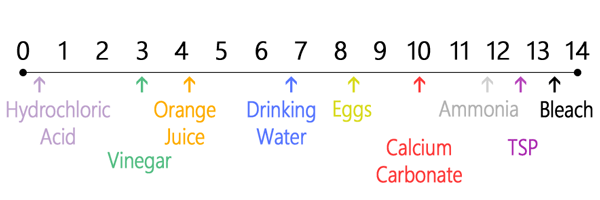Technically, pH is the negative logarithm of the effective hydrogen-ion concentration in gram equivalents per liter of solution. But for those of us whose high school chemistry falls into the category of ancient history, pH is a measure of alkalinity and acidity on a scale of 1 to 14, where 7 represents neutrality and numbers below 7 indicate acidic solutions and those above 7 are alkaline.
The first thing to recognize when dealing with pH is that pH can only be determined in aqueous solutions; that is solutions containing water. It is impossible to directly measure the pH of any solid substance such as salt, concrete or wood. The way the pH of solid materials is measured is by grinding up a sample and soaking the ground sample in distilled water for a period of time. Any component that is water soluble will dissolve in the water thus affecting the pH. The pH of those materials that are totally insoluble in water such as plastic, glass, or oil cannot be measured, and by definition, do not have a pH.
On the pH scale, each unit of change represents a tenfold change in acidity or alkalinity. So a solution that measures a pH of 11 is ten times more alkaline than one that measures 10, and one hundred times more alkaline than one that measures 9. Following is a representation of the pH scale with the pH of some common substances.

Now that we know a bit about pH, how does it relate to log homes? Most wood has a natural pH of around 4 to 6 (measured by grinding up a sample, soaking it in water then measuring the pH of the water solution). We know that anytime an alkaline solution contacts something that’s acidic, some type of chemical reaction occurs. From the pictured scale you can see that both bleach and TSP (trisodium phosphate) have a fairly high pH. It turns out that most stripping and cleaning products like dishwashing soap and laundry detergent also have a high pH. Basic chemistry tells us that solutions of any of these products are going to have some type of impact on bare wood, and the higher the pH the more impact it will have. Of course, solutions having a very low pH like Oxcon™ will have an impact, too, whereas the pH of Log Wash™ is balanced to match the natural pH of wood.
Here is a list of Perma-Chink’s cleaning and stripping products along with their relative pH values:
Product | pH
S-100™ 12 – 13
Wood ReNew (in solution)™ 10 – 11
StripIt® 7.0
Log Wash (diluted) 4 – 5
Cedar Wash™ (RTU) 10 - 11
Oxcon (diluted) 1.5 – 2.5
